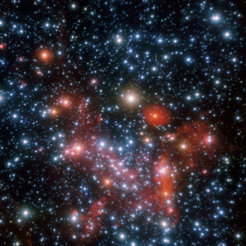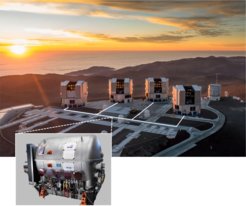Galactic Center Research – Overview
Thanks to its proximity, the Galactic Center is a truly unique astrophysical laboratory for studying in unparalleled detail the properties and evolution of gas and stars in a galactic nucleus and for exploring the physics of strong gravity around a massive black hole. Due to the high extinction, the stars in the Galactic Center are only visible at infrared wavelengths. For three decades, our group has been pioneering infrared observations with the aim of observing these stars. The small angular scales require employing high-angular resolution techniques, the development of which we have been actively pursuing by means of a dedicated instrumentation program. The following figure shows a state-of-the-art near-infrared image of the Galactic Center, obtained with the adaptive optics image NACO at the VLT.

The main result of our work is the proof of existence of an astrophysical massive black hole, beyond any reasonable doubt. The compact radio source Sgr A* is associated with a black hole of approximately four million solar masses (Genzel, Eisenhauer, Gillessen 2010). The proof is as beautiful as it is simple: we have monitored individual, short-period stars on Keplerian orbits around Sgr A*.
The basis of this work is astrometric and spectroscopic monitoring of the central few arcseconds using adaptive optics assisted instruments at ESO's VLT, namely the imager NACO and the integral field spectrograph SINFONI. The GC science case was among the design drivers for both, and our group has led the development of SINFONI, and we contributed also significantly to NACO.

With the advent of near-infrared interferometry, we have opened up a new domain of precision astrometry. Our group is leading the European consortium currently commissioning the GRAVITY instrument for the VLT Interferometer, the design of which precisely matches the observing quests in the Galactic Center.

